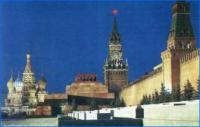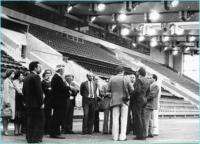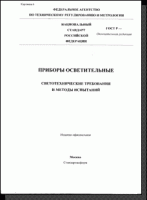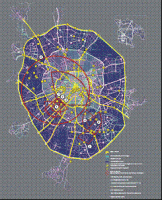Our most significant achievements
Architectural lighting of the Kremlin and Red Square in 1970.
It was the first project, which represented not a festive and temporary, but permanent illumination of the architectural complex of the Moscow Kremlin and Red Square. In the modeling of lighting for buildings we used sketches made with luminous colors (M.I.Agranyan). Project was developed by VNISI specialists: M.I.Agranyan, N.V.Gorbachev, T.A.Trachevskaya, V.M.Tsarkov, M.A.Ostrovskiy and T.L.Flodina. In addition to architectural lighting of the Kremlin, VNISI have always been engaged in illumination of the mausoleum of Vladimir Lenin, and particularly in extremely difficult in the performance lighting the sarcophagus of Lenin.
Official supplier of the XXII Olympiad in Moscow 1980.
VNISI performed a complex of works on illumination of the Olympic Games, developed new principles of illumination for sport facilities, set forth technical specifications for lighting equipment. Based on the results of these studies, projects of sports lighting were designed and implemented.
Lighting a number of stations in Moscow Metro.
In 1983, under the leadership of Yu.B.Ayzenberg V.M.Pyatigorsky (with N.V.Aleshina, from Metrogiprotrans), project of illumination for the metro station "Serpukhovskaya" was implemented.
The world’s first slot waveguides were used in this project. In 1996 subway station "Chkalovskaya" was also illuminated by the same team of authors (this time the arched fibers were first applied).
Solar simulator.
In the 60's and 70's VNISI developed special irradiating devices that simulate solar radiation, the laboratory was established, headed by A.I.Rymov and which included such experienced professionals as V.I.Skoblova, Yu.S.Semenov, O.K.Kusch, N.N. Zhigalina, R.N.Isakov, G.A.Migacheva and others. VNISI created a number of solar simulators of various designs and different power ranges. The most powerful solar simulator in Europe, designed and built in VNISI, provided exposure of radiation, which is close to the sun, with work area of a diameter of 6 m and a height of 22 m. Its capacity was more than 5000 kW. In the simulator there were used 84 of the world's most powerful arc lamps full capacity of 55 kW each.
Numerous and varied studies in the field of space lighting.
VNISI is a developer and supplier of lighting equipment for space applications since the 70s. In the 70's and 80's VNISI equipped a series of orbital stations "Salyut", the space shuttle "Buran", the long-term orbital station "Mir" and modules "Dawn" and "Star" for the Russian segment of International Space Station.
Development and improvement of the regulatory framework for the national lighting.
VNISI traditionally performs the work in the field of standardization in conjunction with the TC 332 "Lighting Products" on lamps, ballasts, ignitors, transducers, control devices, etc.
In the field of international standardization TC 332 "Lighting Products" cooperates with the International Electrotechnical Committee IEC TC 34 "Lamps and related equipment." TC 332 receives handouts of IEC draft standards and changes, as well as organizational information on international standardization of lighting products. TC 332 uses these documents in its work. On the basis of new editions of IEC documents TC 332 updates existing harmonized standards for lighting products. This practice allows us to use the international requirements for lighting products for the development of national standards for lighting products, especially such as LED lights and luminaires based on them.
More information in the appropriate section of the site (Development of SNIP, GOST)
The concept of a single light and color environment of Moscow.
VNISI is an active participant of "General concept of a single light and colour environment of the city with the development of architectural and artistic lighting in Moscow" developers. The purpose of the Concept is to define the principles and methods of forming a single light and colour environment improvement and development of artistically expressive image of the city in the evening time. The Concept is based on the idea of a harmonious use of all means of illumination (external functional, architectural lighting, advertising lighting, festive lighting) to increase the level of comfort and safety of the light environment of the city, improving its architectural and artistic qualities in the evening and night time.
The concept formulated specific lighting requirements for Moscow's light and colour spaces (panoramas, views), defined by architects and the lighting designers, with a harmonious application of all types of outdoor lighting. Particular attention is paid to the selection of radiation spectrum of used light sources.
The estimation of energy supply for the formation of light and colour environment of the city, which includes, besides the traditional recommendations for the use of energy efficient light sources, efficient appliances and lighting control systems, a number of prohibitions on the use of inefficient methods and means of illumination, was performed. It should be emphasized, that also we should toughen the requirements of operation, including the organization and monitoring using a mobile laboratory, for compliance with lighting requirements, and identify violations of the fundamental concepts of the lighting.
At the present time, in Moscow a large-scale implementation of this concept is being launched.
List of the most significant works:
- Method of amplification of electromagnetic radiation, based on the phenomenon of stimulated emission (Diploma of the discovery #12, December 1964. by V.A. Fabrikant, M.M. Vudynsky, F.A. Butaev);
- The theory of visual perception (S.O. Meisel);
- Establishment of fluorescent lamps and their implementation (V.A. Fabrikant, F.A. Butaev, V.I. Dolgopolov);
- Experimental determination of the speed of light (K.S. Wolfson);
- Colour Theory (D.A. Shklover, R.S. Joffe);
- Research and creation of electronic flash light sources (K.S. Wolfson, I.S. Libin, I.M. Gurevich);
- Research and development of gas discharge lamps (G.N. Rohlin);
- Principles of design of lighting fixtures (Yu.B.Ayzenberg);
- Principles of lighting of closed objects (L.P. Varfolomeev);
- Principles of regulation of lighting installations. Development of norms SNiP, MGSN and others (Ts.I. Krol, M.A. Ostrovsky, G.V. Fedyukin);
- The method of calculating the service life of lamps (Yu. B. Ayzenberg, N.V. Rozhkov);
- Standardization of lighting devices. Test methods, quality control, certification (Yu.Ayzenberg, M.A. Zozulya, A.V. Ochkin, A.I. Zapenin, T.N. Nikiforov);
- Creation of a light masking techniques (Z.M. Gorev, A.I. Ivanov);
- Basic architectural and sports coverage (N.V. Gorbachev, V.M. Tsarkov, V.M. Piatigorsky);
- Architectural lighting the most important objects of the country (N.V. Gorbachev, V.M. Tsarkov, G.V. Boos, V.M. Piatigorsky);
- The complex studies of low-pressure mercury discharge fluorescent lamps and their development in 1948-1990. (F.A. Butaev, V.V. Fedorov, G.V. Boos, E.P. svyatsova, E.M. Erashova, S.L. Rybalov);
- Illuminance of the Kremlin stars (N.V. Gorbachev - State Award);
- Creating a color and light environment of Moscow (G.V. Boos, V.M. Piatigorsky - State Award);
- The complex of the study and creation of metal halide and sodium lamps for lighting - 1965-1990 (G.N. Rokhlin, Z.L. Kobina, E.B. Volkov, V.M. Pchelin, etc.);
- Complex calculation, experimental research and the creation of heavy-duty metal short-arc xenon lamps up to 100 kW. 1960-1982. (G.I. Rabinowitz , V.S. Schumanov, M.F. Yashchenko);
- The complex research, design and technology and material science works in the field of hollow fibers. (Yu. B. Ayzenberg, V.M. Piatigorsky, A.A. Korobko, G.B. Buchman);
- Establishment of the Technical Committee "hollow fibers" (Yu. B. Ayzenberg);
- The complex of works on the theory and practice of radiation in the technological and biological processes 1965-1985 (G.S. Sarychev, G.N. Gavrilkina, L.B. Prikupets, E.L. Mudrak, S.G. Ashurkov);
- Creation of the first metal halide (mercury-thallium) lamps and metal halide lamps in the implementation of irradiators, 1964-1990. (G.N. Rokhlin, G.S. Sarychev, G.N. Gavrilkina, S.G. Ashurkov, V.M. Pchelin, L.B. Prikupets);
- The complex studies of photoculture for plants, determined the requirements for light sources and lighting devices, the introduction of mass production in crop lighting in 1970-2000. (G.S. Sarychev, L.B. Prikupets, E.I. Mudrak, S.G. Shvetsov);
- The complex of the Lighting for the Olympics-80, 1976 - 1980. (G.R. Shahparunyants, P.V. Plyaskin, J.A. Bukhanov, V.M. Tsarkov);
- Research and development of lighting, signaling, search and measuring devices in the field of underwater lighting (N.V. Chernysheva, N.S. Libin, L.P. Varfolomeev, A.S. Chernyak);
- Creation and production of lighting and light signaling devices for manned space objects (the "Soyuz", space stations "Salyut" and "Mir", shuttle "Buran"), 1976 -2010. (V.P. Chernyshov, B.M. Vodovatov, V.G. Baryshnikov, L.P. Varfolomeev, G.V. Magiev, V.G. Gusev, T.S. Leonova, A.V. Leonidov, M.V. Smirnov, S.V. Petrova, A.V. Leonov, V.N. Kolesnikov, P.I. Parshin, T.V. Belyakova, I.D. Epelfeld)
- Creation and production of pulse beacons for the capsules and landers ,1975-2000. (V.P. Chernyshov, B.M. Vodovatov, V.G. Baryshnikov, V.P. Zhiltsov, M.E. Konkov, A.G. Tretyakov, M.V. Smirnov, A.I. Androsov, V.K. Shevchuk, P.I. Parshin, I.D. Epelfeld)
- Development of a new generation of lighting devices for military equipment and special facilities to order the Defense Ministry, 2004-2010. (V.M. Piatigorsky, V.A. Maiorov, A.V. Leonov, G.S. Sarychev, G.N. Gavrilkina, V.I. Infimovsky, M.V. Smirnov, S.V. Petrov).
- Establishment of the CIE Technical Committee TC 1.8 "Photochemistry and Plant," 1979 (Chairman G.S. Sarychev);
- Development and establishment on the basis of internationally renowned journals VNISI "Light" and «Light and Engineering»;
- Writing and publication of monographs, textbooks for high schools and colleges, reference books (G.N. Rokhlin, M.A. Ostrovsky, R.A. Sapozhnikov, Yu. B. Ayzenberg, G.S. Sarychev, M.I. Fugenfirov, J.A. Bukhanov, P.V. Plyaskin, V.V. Fedorov).







